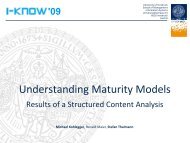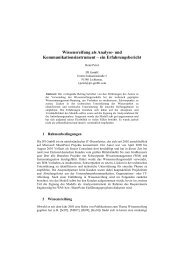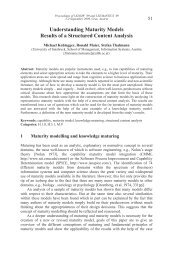MATURE Deliverable 1. - Knowledge Maturing
MATURE Deliverable 1. - Knowledge Maturing
MATURE Deliverable 1. - Knowledge Maturing
Create successful ePaper yourself
Turn your PDF publications into a flip-book with our unique Google optimized e-Paper software.
40<br />
• Influence on personal development. Nearly all cases analyzed showed, that continuous learning<br />
was needed in order to execute their tasks. In some cases, advancing on the career path would<br />
greatly be influenced by acquiring new knowledge.<br />
• Formal training . Formal learning in the form of INSET training, continuing professional<br />
development opportunities and formal education courses played a significant role for maintaining<br />
and developing the knowledge of those in contexts responding to rapid change.<br />
• Informal learning and development. Within most of the organizations, the continuous need to<br />
learn and maintain knowledge was an essential element of their job role. Informal learning was an<br />
essential method of maintaining knowledge. For instance, individuals were required to have upto-date<br />
knowledge and information on local education, training and employment opportunities.<br />
However, there were few formal processes for recording, storing and sharing this knowledge.<br />
• Occasion. Nearly all of the cases had in common, that a lot of learning had to be done parallel to<br />
work.<br />
Area 4 (artefacts): Which forms of representation for knowledge or artefacts are important in the<br />
company’s daily operations, e.g., formalized training material, contributions in community platforms,<br />
emails? Why?<br />
• Artefact. Most content types were either documents related to the daily business like project<br />
presentations or meeting protocols or they were knowledge oriented like FAQ-lists, product<br />
documentations or stored answers from colleagues to a certain problem.<br />
• Formalization. Artefacts with all levels of formalization were found.<br />
• Location. There were different specific locations used like file servers or PIM (see Area 5 below).<br />
However, artefacts could be stored in more than one location, especially, if the regarding content<br />
would exist in different stages of formalization.<br />
• Organizational vocabulary. Often the vocabulary used is organisationally prescribed and policy<br />
driven relating to professional identify. Language and vocabularies are shared across, and<br />
embedded within, the organization and comprise part of the knowledge structures.<br />
Area 5: How are individual and group work spaces structured, e.g., own file system, file servers, email<br />
archive? Which concepts are used? Why?<br />
• Type of workspace. All employees personal and one or more group workspaces relevant for their<br />
work.<br />
• Location. The primary location for storing documents and information were file servers and the<br />
PIM. Other, less common locations were wikis, document management systems, portals or<br />
specific application systems.<br />
• Contents. Most content types were either documents related for the daily business like project<br />
presentations or meeting protocols or they were knowledge-oriented like FAQ-lists, product<br />
documentations or stored answers from colleagues to a certain problem (see Area 4).<br />
• Concept. The primary concept for structuring the personal and group workspace was that of a<br />
hierarchy which was, in many cases, sorted by task or time dimension.<br />
• Changeable. Although all personal workspaces were changeable by the employees, a lot of group<br />
workspaces had a fixed structure, whether due to administrative issues or standardization efforts<br />
of the application partner.<br />
• Formats. The workspace of most employees contained typical office formats like MS Word,<br />
Excel, PowerPoint and stored email messages.<br />
• Responsibilities for updating. Depending on the system used for storing information, either<br />
everybody could update specific contents (wiki), or specific roles were defined being responsible<br />
for keeping information and knowledge up-to-date. In addition, there were some examples of not







